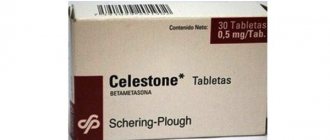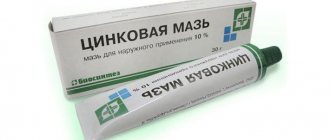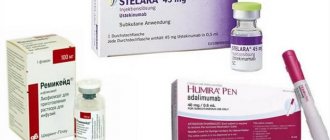Diprospan is a hormonal drug of prolonged action, which is prescribed for the development of psoriasis, erythroderma, psoriatic arthritis and other skin diseases.
Diprospan for psoriasis is prescribed only as a last resort, when other medications have proven ineffective.
Reviews from doctors and patients about Diprospan are very contradictory. Some believe that one injection of Diprospan is CAPABLE OF PROVIDING THE PATIENT WITH A LONG-TERM REMISSION, while another group claims that its use is DANGEROUS WITH SIDE EFFECTS.
Description of the pathology
Psoriasis is a common skin disease of a chronic type, which is characterized by the appearance of a monomorphic rash of flat papules that tend to merge into large plaques that are covered with silver-white loose scales. The disease has a wavy course.
The etiology of psoriasis is not fully understood, but scientists believe that the most likely infectious, hereditary and neurogenic nature of the origin of this disease. The risk group includes people with frequent skin trauma, disorders of the central nervous system, the presence of streptococcal skin infections, and endocrine pathologies.
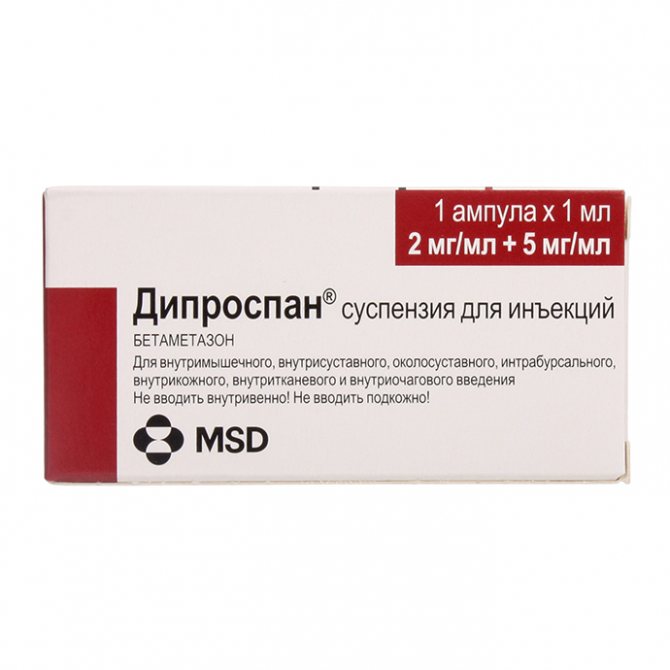
The initial element of psoriasis is a single papule, pinkish in color, covered with white scales. At the stage of development of the disease, there are few rashes, but their number gradually increases. The next stage is characterized by the appearance of new elements at the sites of injuries, scratches and abrasions on the skin. Newly emerging elements begin to merge with existing ones and form symmetrical plaques. At the third stage, the growth rate of plaques decreases, their borders become more distinct, and the skin acquires a bluish color. Severe peeling is observed. Exudative psoriasis differs from ordinary psoriasis in the presence of crusts on the plaques, which are formed due to impregnation with exudate. Psoriasis of the soles and palms may also occur.
In severe forms of the disease, small intraepidermal pustules appear on the infiltrated skin, which merge and form purulent areas. According to reviews, Diprospan is very effective for psoriasis. Doctors also note this.
Causes and manifestations of the disease
The disease manifests itself first as single, and then as multiple, eruptive elements on the skin - the so-called psoriatic plaques. Such formations are raised, inflamed red spots with a silver-gray flaky surface that rise significantly above the surface of the healthy epidermis. The upper scales are easily removed with the slightest mechanical impact, a smooth (terminal) film remains in their place, and small droplets of blood (“blood dew”) appear.
The only precisely established fact about psoriasis is its genetic nature. Thus, it is impossible to become infected with a disease through close contact with an already sick person, but inheriting it is as easy as shelling pears. The results of scientific research are disappointing: the risk of developing psoriasis for those people whose parents have encountered this pathology increases to 70-75%. If we are talking about other immediate relatives, the figure drops to 60-65%.
Unfortunately, the nature (etiology) of psoriasis has not been fully established. Most experts are inclined to believe that this disease has an autoimmune origin.
Thus, according to the main postulate of this approach, the appearance of psoriatic plaques on the skin is to blame for the body’s defenses, which, under the influence of conditioning factors (infections, stress, poor nutrition, taking certain medications), begin to intensively attack healthy epidermal cells, triggering the mechanism of their abnormal reproduction.
This pathological process leads to the fact that the skin of patients with psoriasis gradually becomes overgrown with characteristic inflamed, itchy, scaly lesions.
There are other theories of the origin of this systemic disease:
- Allergic;
- Toxic;
- Medicinal;
- Neurogenic (stressful);
- Metabolic (exchange);
- Hormonal (endocrine).
According to dermatologists, pathogenic factors such as intense psycho-emotional experiences, poor nutrition, past infectious or viral diseases, frequent hypothermia or excessive exposure to direct sunlight serve as triggers for exacerbations of the disease.
Unlike other dermatological diseases, psoriasis does not have characteristic favorite localization sites. Rashes are found on the flexor surfaces of the upper and lower extremities, abdomen, back, face, neck, palms and soles, and can spread throughout the body (with a generalized form of the disease). It is noteworthy that psoriasis of the scalp, joints, and nail plates is considered to be separate types of pathology. In severe cases, the disease spreads to internal organs.
The fact that the true causes of the development of psoriasis have not been established determines the absence of a single universal treatment regimen that could once and for all relieve patients with the corresponding diagnosis from its unpleasant manifestations.
Therapy for psoriasis is exclusively symptomatic and is aimed at relieving unpleasant sensations on the skin and preventing exacerbations. Thus, patients are prescribed systemic drugs of various spectrums of action, local remedies (creams, ointments, gels, sprays, shampoos), physiotherapy, as well as effective folk formulations are used in the fight against signs of illness. In addition, the fight against psoriasis is not complete without a therapeutic diet designed to facilitate the work of the gastrointestinal tract.
Important addition: Details about cryodestruction of papillomas as a method of removing them
The treatment regimen used to treat one or another form of psoriasis is exclusively individual in nature and is selected by a dermatologist based on the type, severity, localization of skin manifestations of the disease, as well as after a comprehensive assessment of the patient’s general health.
Composition, release form
This medication is produced in the form of an injection suspension: colorless or slightly yellowish, transparent, slightly viscous, containing suspended white particles, free of impurities. When dissolved, a white or yellowish suspension is formed.
The drug contains the following active elements: betamethasone sodium phosphate and betamethasone dipropionate. Excipients are: sodium hydrogen phosphate dihydrate, disodium edetate, sodium chloride, polyoxyethylene sorbitan monooleate, methyl parahydroxybenzoate, benzyl alcohol, propyl parahydroxybenzoate, macrogol, sodium carmellose, hydrochloric acid.
The suspension is packaged in glass ampoules and plastic blister packs of 1 or 5 ampoules.
Pharmacological properties
Reviews of Diprospan injections for psoriasis are mostly positive. The drug has immunosuppressive (immune suppression), anti-inflammatory, anti-shock, anti-allergic and desensitizing (decreasing the body's sensitivity) effects. The active component - betamethasone - is presented in the medication in 2 forms: betamethasone disodium phosphate, which ensures the rapid onset of the desired effect, and betamethasone dipropionate, which serves to prolong the action of this medicine.
The widespread use of the drug for psoriasis and other diseases is due to its ability to suppress the production of substances that cause inflammatory reactions and block the inflammatory process at the cellular level. In addition, the drug has a slight ability to retain sodium in the body and increase the level of excretion of potassium, hydrogen and ammonium ions, but when used in recommended doses, such properties have no clinical significance. This is confirmed by the instructions and reviews of Diprospan injections for psoriasis.

Prednisolone or Diprospan?
Prednisolone is a synthetic hormonal drug that has a wide range of uses. It acts on foci of inflammation, affects carbohydrate metabolism, reduces the production of allergy mediators, and is used in the treatment of autoimmune diseases, as it normalizes the functioning of the immune system. These properties allow the drug to be widely used in the treatment of scaly lichen as part of complex therapy. It is available as an ointment, in tablet form and as a solution for injection. Initially, for psoriasis, topical application of the hormone is prescribed. The ointment is applied to the affected areas several times during the day, and a compress is applied to enhance the effect. If there is no effect, tablets or injections are prescribed. Prednisolone is contraindicated in children with tuberculosis, human immunodeficiency virus, skin infections, pregnant and lactating women. If you need to decide which drug to use in treatment - prednisolone or also the hormonal diprospan - then you should pay attention to their distinctive features. The use of prednisolone negatively affects the metabolism of minerals, but Diprospan does not affect it.
Indications
The medication is recommended for use in psoriasis, as well as some complications caused by this pathology:
- psoriatic arthritis;
- erythroderma;
- generalized psoriasis.
In addition, injections can be prescribed for extensive severe skin lesions from plaques, when they form in large quantities, bleed heavily, and secrete exudate. You cannot use Diprospan injections for psoriasis on your own. The decision about the need to administer medication can only be made by the attending physician.
According to the instructions, Diprospan is also prescribed for the following pathologies:
- diseases of the musculoskeletal system, including osteoarthritis, rheumatoid arthritis, bursitis, epicondylitis, ankylosing spondylitis, radiculitis and more;
- allergic diseases, including hay fever, bronchial asthma, rhinitis and others;
- dermatological diseases, including coin-shaped eczema, atopic dermatitis, neurodermatitis, contact dermatitis, photodermatitis;
- systemic connective tissue diseases;
- hemoblastosis;
- adrenal insufficiency.
This list includes many other diseases that require the use of glucocorticosteroids.
When is it recommended to use
It is recommended to use this remedy only when prescribed by your doctor. The main indicators are:
- severe form of psoriasis;
- psoriatic arthritis.
Instructions for use of Diprospan state that, in addition to psoriasis, it treats the following diseases:
- lupus;
- myositis;
- scleroderma;
- various skin inflammations;
- acute pedagogical arthritis;
- diseases of the joints and connective tissues;
- allergic rhinitis;
- some intestinal diseases;
- bronchial asthma;

The drug is also indicated in the treatment of allergic rhinitis
- for various kidney diseases;
- diseases associated with the circulatory system.
Typically, this drug is prescribed only for inpatient treatment, in order to control the clinical picture, as well as to prevent the condition from worsening.
Use during pregnancy
The use of Diprospan during pregnancy and lactation requires careful consultation with a doctor, who may prescribe the drug with extreme caution.
But most often, experts do not recommend its use during this period, since, in addition to numerous side effects, it can negatively affect the body of the expectant mother, the child (since the components can penetrate the placenta and mother’s milk) and its further development.
If the drug was used before pregnancy, it is recommended to gradually reduce the dose.
Instructions for use of "Diprospan" for psoriasis
This medication is used in the form of intramuscular injections, as well as for peri- and intra-articular, intradermal, intralesional, intrabursal and interstitial administration. The small size of betamethasone dipropionate crystals allows the use of small diameter needles for direct injection into the lesion. Injections should be carried out with strict adherence to aseptic standards, according to the instructions. “Diprospan” for psoriasis is administered and dosed individually, which depends on the indications, clinical picture, severity of the pathological process and the patient’s response.
When used systemically, the initial dosage of the drug in most cases is 1-2 ml. The course of treatment with Diprospan for psoriasis should be repeated as needed, taking into account the patient’s condition.
How exactly to give injections?
The most common method of administering the drug into the body is intramuscular. It is better to find out in advance how to inject Diprospan for psoriasis. The medication is injected deep into a large muscle, avoiding penetration into other tissues (to prevent the development of tissue atrophy).
In the presence of severe conditions that require emergency treatment, the initial volume of the suspension is 2 ml. For moderate illness and other dermatological diseases, in most cases, administering 1 ml of medication is sufficient. What else does the instructions for use of Diprospan injections for psoriasis tell us?
In addition, local administration of the drug is used in treatment. However, the simultaneous use of a local anesthetic is necessary only in rare cases. If necessary, in such a situation, use 1% or 2% solutions of lidocaine or procaine hydrochloride, or other similar substances that do not contain propylparaben, methylparaben and phenol. Mixing of liquids is carried out in a syringe - first of all, the required dosage of Diprospan is drawn into it, then the required volume of local anesthetic is drawn with the same syringe.
For psoriasis, intravenous injection of a medication into the lesion is also very effective, which is evenly pricked using a tuberculin syringe and a needle with a diameter of no more than 0.9 mm.
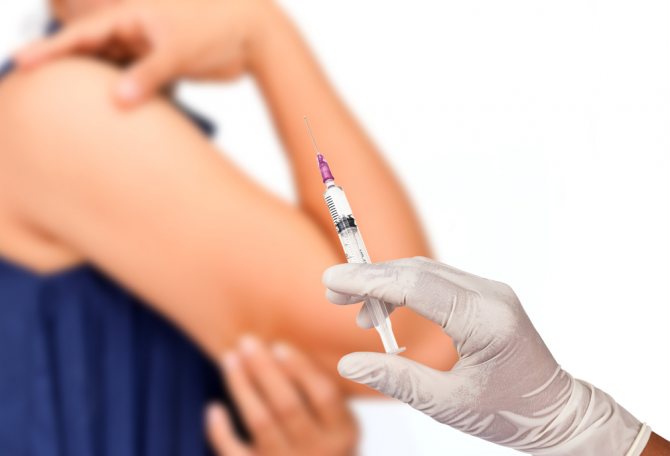
After achieving the required therapeutic effect, the maintenance dosage is selected by lowering the dose of betamethasone, which is carried out at intervals until the minimum dose is reached.
If there is a threat or immediate occurrence of stressful situations (a risk factor for the development of exacerbation of psoriasis), it may be necessary to increase the dosage of the Diprospan suspension. Discontinuation of the drug after long-term treatment is carried out by gradually reducing the dosage.
Monitoring of the patient's condition should be carried out for at least a year after completion of therapy or use of the medication in high dosages.
The following groups of patients should be treated with caution when using Diprospan injections:
- People suffering from arterial hypertension (high blood pressure).
- Those who suffer from serious disorders of the nervous system experience strong psycho-emotional experiences.
- “Diprospan” and psoriasis are incompatible in the presence of purulent-infectious processes on the skin.
- You should not inject the drug to those whose skin is affected by viral and fungal infections.
- The drug is contraindicated in patients with diabetes mellitus types I and II.
- People with osteoporosis.
- You cannot give Diprospan injections for glaucoma, tuberculosis, thromboembolism, or stomach ulcers.
Medication to combat the symptoms of psoriasis is prescribed in short courses. This is a strong drug, an overdose of which is fraught with a number of serious side effects. Reviews about the treatment of psoriasis with Diprospan confirm this.

How often can Diprospan be injected intramuscularly for psoriasis?
Diprospan injections for psoriasis are produced by the Swiss pharmaceutical company Schering Plow. In the market of the CIS countries, injections for psoriasis Diprospan have won their customers thanks to the effective action of active substances, allowing patients to achieve long-term remission.
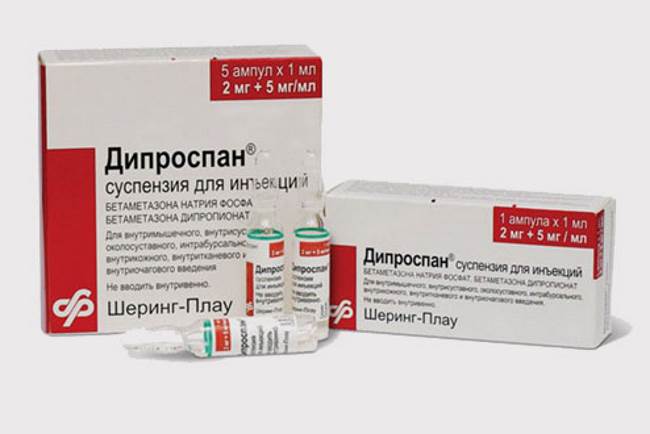
Diprospan is produced in ampoules, the main active ingredients are betamethasone dipropionate and betazone sodium phosphate. Both of these substances are very similar to each other, but differ in the speed of their action. Betazone sodium phosphate has a faster effect - it exerts its positive effect within a matter of hours, and the substance leaves the body in the first day. Betamethasone dipropionate has a prolonged effect - this component affects the patient’s body within ten days after use.
Based on this, you can inject Diprospan for psoriasis every two weeks to maintain a period of remission for as long as possible. Diprospan should be taken three times for psoriasis, so the course of treatment is one and a half months.
Doctors' reviews of Diprospan for psoriasis are quite categorical - most doctors do not recommend using the drug and consider it an extreme case when you need to resort to it. At the same time, patient reviews of Diprospan for psoriasis are so varied that it is difficult to form a clear attitude towards the drug. Whether Diprospan helps with psoriasis is one of the controversial issues discussed by patients. The drug is actively discussed in the forum of people suffering from this disease. As an example, I will give a few reviews.
- Sergey, 27 years old, Moscow. Diprsopan for psoriasis was my last hope. At the very beginning of treatment for the disease, the doctor said that if other drugs had no effect, he would prescribe me the most powerful drug. As it turned out, it was Diprospan. The doctor introduced me to all the features of these injections, even managed to scare me about the side effects, but I didn’t experience any of those. But the psoriatic plaques, which caused me great discomfort, began to disappear. I hope that the positive effect will last as long as possible.
- Elena, 54 years old, Kyiv. I have suffered from psoriasis since childhood, I have tried many medications, which were treated by several specialists. One of the doctors advised me to pay attention to the drug Diprospan. He warned that this is a hormonal drug that not only works effectively, but also provokes side effects. I won’t say that I felt worse after the Diprospan injections, but I didn’t see a huge breakthrough in treatment either. Psoriasis became only a little easier to bear, the itching and burning disappeared, but the skin problems did not disappear. I don’t think that treatment of psoriasis with Diprospan was effective for me.
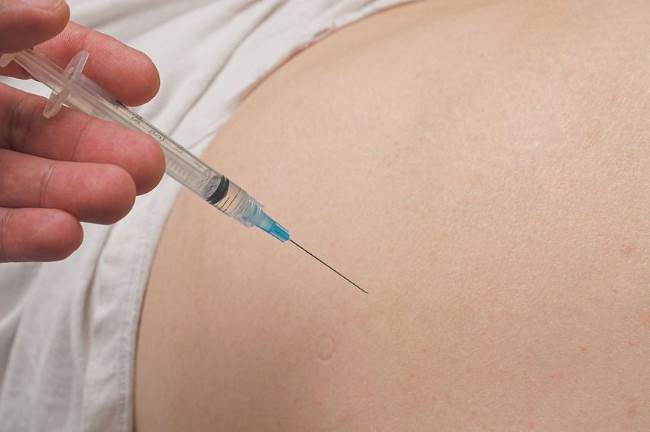
The instructions for using Diprospan for psoriasis state that the drug can cause side effects from one injection , so injections should only be done in a medical facility. The procedure is carried out only by a competent specialist. It is very important to inject Diprospan correctly for psoriasis, because even one incorrect procedure can cost your life. For example, it is strictly forbidden to inject the drug intravenously - this can cause death.
Injections of the drug are not painful. The drug for psoriasis is injected intramuscularly, using one ampoule with an injection solution for administration. The most convenient location for the injection is the gluteal muscle. Before introducing the product, warm it up a little in your hand so that there is no temperature difference. According to experts, Diprospan does not need to be injected a lot for psoriasis; how many injections are needed depends on the reaction to the drug. Usually, for the treatment of psoriasis, it is enough to give three injections so that the disease recedes and a period of remission begins. The medicine Diprospan for psoriasis is administered three times, so the course of treatment with the drug does not tie the patient to the clinic for a long time.
After the injection, the patient must remain under medical supervision for some time to monitor the reaction to the drug.
The use of Diprospan for psoriasis is currently a controversial issue. As doctors note, the drug has a high risk of side effects, for example, itching with psoriasis, and the convergence of psoriatic plaques in some patients occurs only when using the drug. As soon as the effect of the third injection ends, the disease worsens again.
Doctors warn that Diprospan should be used very carefully for psoriasis. There is a high risk of hormonal dependence on the drug, so in patients after stopping taking the drug, the pathology worsens even more. Diprospan against psoriasis may not only not help, but also harm the patient’s health. Therefore, if the patient has the first signs of psoriasis, there is no need to immediately treat the disease with potent drugs. In some cases, at the initial stage, the disease can be eliminated with drugs that are less harmful to health.

Based on the indication for use of the drug - psoriatic skin lesions - one should not forget that the drug has contraindications. Diprospan's contraindications are quite wide: diabetes mellitus, fungal skin infections, infectious processes, hypertension, glaucoma, ulcerative lesions of the stomach walls and others. This significantly narrows the circle of people who can administer Diprospan for psoriasis, because even one injection of this potent hormonal drug can cause serious harm to the patient’s health. The side effects of Diprospan should not be ignored; it is much better to use other drugs.
The drug Diprospan has analogues among other drugs, but still some indicators differ. For example, Stelar injections for psoriasis can be done much more often. Thus, the course of treatment is extended, but there are no side effects.
Many patients with psoriasis have received Methotrexate injections for psoriasis, which are considered more effective and safe. A similar medicine that is used in the form of injections for psoriasis is Remicade. An analogue of Diprospan for psoriasis in ampoules - the drugs Humira, Metipred and others. A substitute for Diprospan in injections for psoriasis is the drug Diprosalik, which also has a positive effect on the condition of the skin.
The price of Diprospan for psoriasis is quite affordable, taking into account the fact that only a few injections are needed. The price of 1 ampoule of Diprospan ranges from 220-250 rubles. The package contains 5 ampoules, which can be purchased for 870-900 rubles. Buying Diprospan in Moscow at a pharmacy may be more expensive, then you should use the services of online pharmacies. In Ukraine, the cost of one ampoule ranges from 240 to 400 UAH in various pharmacies, and the lowest price for a whole package is 1164 UAH.
Based on materials from www.psoriazo.ru
It has long been believed that it is impossible to get rid of psoriasis for good. To alleviate the condition and reduce symptoms, it is necessary to use expensive medications for a long time. Is it really? Much has been said about methods of combating psoriasis, but which one is the most effective? We'll figure out!
Diprospan for psoriasis is a panacea for a terrible and unpleasant disease. After all, everyone knows that injections have the most effective effect on the disease, and only they can relieve the negative manifestations of the disease.
The use of diprospan for plaque, erythrodermic psoriasis and psoriatic arthritis has an irreplaceable therapeutic effect.
Diprospan from the group of glucocorticosteroids (hormonal agent) has a prolonged effect. The high effectiveness of the drug causes multiple effects on metabolic processes in the body. The drug consists of 2 components that are similar in composition, but different in the speed of action:
- Betamethasone sodium phosphate. The component can easily dissolve, is capable of rapid absorption after administration, and provides a rapid therapeutic effect. It is eliminated from the body after 24 hours.
- Betamethasone dipropionate. It is typically eliminated from the body gradually, over 10–12 days, which ensures a long-term medicinal effect of the drug.
Currently, for psoriasis, specialists constantly use diprospan, since the action of this medication is aimed at:
- Relieving the inflammatory process on the skin,
- Desensitizing effect,
- Antitoxic,
- Immunosuppressive.
The drug is available in ampoules of 1 milliliter. Injections for psoriasis are prescribed one or two ampoules deep into the gluteal muscle. How often can you inject the drug? The interval between two injections is from 10 to 14 days. Course of treatment: three or five-time administration of the drug is prescribed.
- The drug is administered only as prescribed by a doctor;
- Injections are carried out in a medical facility;
- Strict adherence to dosage.
According to modern technologies for the treatment of psoriasis, some experts recommend intradermal administration of diprospan directly into the lesions.
The recommended dosage of the drug is 0.2 milliliters per square centimeter of the affected surface. A uniform puncture of the lesion is carried out using a tuberculin or insulin syringe with a thin needle. The number of injections of the drug into all affected areas should not exceed 1 milliliter per 7 days.
The use of diprospan for psoriasis is contraindicated if you have:
- Severe hypertension;
- Diabetes mellitus of insulin-dependent type;
- Tuberculosis of various organs;
- Peptic ulcer;
- Glaucoma;
- Thrombocytopenic purpura.
Treatment of psoriasis with diprospan in a short course (3 injections) does not cause negative reactions. Long-term and irrational use of the drug in high doses produces adverse reactions:
- anaphylactic shock, allergic manifestations;
- gastrointestinal (digestive system disorders, exacerbation of chronic diseases);
- from the nervous system (excitement, anxiety, neuroses, convulsions);
- changes in metabolic processes (increase in body weight, delayed development and growth in children, increased blood sugar levels, osteoporosis);
- increased blood pressure and susceptibility to infections;
- development of ophthalmological diseases (glaucoma, cataracts).
Exceeding the dose of medication can provoke: sleep disturbance, nausea, euphoria, agitation. More detailed instructions are included in each package of the drug.
The main principle of the rational use of diprospan for psoriasis is: do not self-medicate and strictly adhere to all recommendations of the attending physician, especially regarding the dosage of the drug and the interval between injections.
Have you already tried a drug to treat a disease? Help others - leave your reviews and share this material!
Based on materials from dermalive.ru
Usually, for psoriasis, a serious skin pathology, external remedies are used to relieve symptoms, reduce the number of plaques, itching, and other manifestations of the disease. However, in severe forms of the disease, more serious methods of therapy may be required, for example, Diprospan is used for psoriasis. It is worth considering the instructions for use and the main cases when this remedy is needed, what the pros and cons are, and the consequences of using the drug for skin pathologies.
Sometimes, with severe forms of psoriasis, inflammatory processes occur, exudate is released, all this is accompanied by severe itching and other painful symptoms. To relieve such symptoms in this disease, simple remedies against peeling and itching are not enough. In severe cases, the use of hormonal drugs is required.
Most often, hormonal external ointments are used for treatment. They help relieve severe inflammatory processes, relieve itching, and help prevent the formation of new plaques and the spread of old ones. Hormonal drugs for treatment can only be prescribed by the attending physician, since their effects are too intense and there is a high probability of side effects if used incorrectly.
Diprospan is a hormonal agent in the form of an injection suspension. This drug quickly begins to inhibit the development of the inflammatory process in the body, while its effect is quite long-lasting, the effect does not disappear immediately. Typically, this remedy is not prescribed for simple forms of psoriasis; such serious treatment may be needed only if complications develop against the background of this disease.
The drug contains two components; this product is combined, which is why the effect of its use is so pronounced. One component helps remove the symptoms of the disease, the second helps maintain the effect, so frequent injections are not required to maintain the effect.
Analogs of this drug are other hormonal-based anti-inflammatory drugs. These include medications based on hydrocortisone; it is most often used in the treatment of psoriatic disease. What can replace Diprospan for psoriasis can only be suggested by the attending physician, since this disease in all cases requires an individual approach.
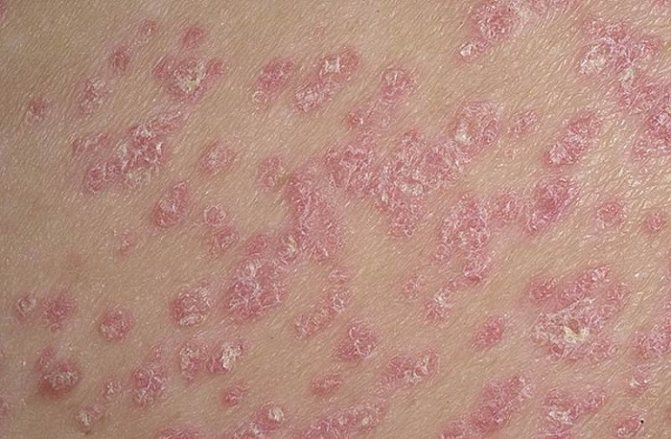
The main indications for the use of Diprospan are various inflammatory processes in the body. Psoriasis is not the main indication for the use of such a drug, but its possible complications may be a reason to use the drug.
Diprospan can be used for the following complications of psoriasis:
- psoriatic arthritis;
- generalized psoriasis;
- erythroderma against the background of psoriasis.
Based on materials from 1psoriaz.net
It is almost impossible to achieve stable remission of psoriasis without glucocorticosteroids. These drugs successfully cope with allergic reactions, relieve inflammation, prevent the spread of psoriatic rashes, and “dry out” plaques.
Diprospan is a good and at the same time inexpensive corticosteroid. This medicine has anti-inflammatory, immunosuppressive, antishock and antihistamine effects.
The release form of Diprospan is a suspension/solution for injection. The price of the medicine is 100-110 rubles (the price is indicated for 1 ampoule). The manufacturer of the drug is Schering-Plough. The medication is released mainly by prescription.
Doctors are often asked whether Diprospan can be injected for psoriasis, or will the drug be ineffective? According to dermatologists, the medicine is excellent for the treatment of lichen planus.
Diprospan is a truly effective corticosteroid. Its active component is betamethasone dipropionate. The ampoules also contain excipients that do not have pharmacological activity - sodium edetate, hydrochloric acid, injection water, methyl parahydroxybenzoate, nipagin, sodium chloride, sodium phosphate, benzyl alcohol, sodium salt, polysorbate 80, polyethylene glycol, Trilon B, propyl parahydroxybenzoate.
The mechanism of action of the drug is based on inhibition of the release of interleukins types 1 and 2. In addition, the drug inhibits the release of interferon-gamma from lymphocytes and macrophages.
The drug has antihistamine, antishock, anti-inflammatory, immunosuppressive, antitoxic and desensitizing effects. The instructions say that the product does not affect the levels of circulating beta-endorphin. In addition, when using injections, the release of ACTH and beta-lipotropin from the pituitary gland is not suppressed.
However, the description notes that Diprospan has the ability to inhibit the synthesis of FSH and TSH, but at the same time stimulates the production of erythropoietin, increases the number of red blood cells, reduces the number of lymphocytes and eosinophils, and also increases the excitability of the central nervous system.
Diprospan reduces the amount of protein, but still, when using the drug, the globumin-albumin ratio increases, and there is also an increase in protein catabolism directly in muscle tissue. The medication affects lipid and water-electrolyte metabolism.
The antihistamine effect of injections is achieved due to the fact that the corticosteroid suppresses the secretion and synthesis of allergy mediators and inhibits the process of antibody formation. The immunosuppressive effect is caused by reducing the rate of cytokine release.
Betamethasone is rapidly absorbed and has a prolonged effect.
Let's look at the instructions for use for Diprospan for psoriasis, but first we will establish what indications for use the medication has. In fact, the remedy is used in many areas of medicine.
Indications for use are psoriasis, shock (cardiogenic, surgical, burn, traumatic, blood transfusion, toxic type), anaphylactic shock, allergic reactions, arthritis, cerebral edema, bronchial asthma, acute adrenal insufficiency.
The list of indications also includes rheumatoid arthritis, SLE, poisoning with cauterizing liquids, acute hepatitis, hepatic coma, thyrotoxic crisis, and various systemic connective tissue pathologies. For diseases of the musculoskeletal system, a blockade with Diprospan is used.
How much and how often to give a corticosteroid injection is decided by the attending physician. Initially, the suspension should be diluted with 0.9% NaCl solution or dextrose. The optimal daily dosage is considered to be 4-8 mg. The injection is given once a day. The solution is administered intramuscularly or intradermally.
How often can Diprospan be injected intramuscularly for psoriasis? Of course, you cannot use the medicine on an ongoing basis. As a rule, a corticosteroid is used during an exacerbation of autoimmune pathology.
The duration of use of Diprospan is limited to 2-4 weeks.
The drug is contraindicated in cases of hypersensitivity to its components, periarticular infections, septic lesions of the joint, periarticular osteoporosis, severe bone destruction, aseptic necrosis of the epiphyses of bones.
The list of contraindications also includes infectious and bacterial lesions, fungal lesions of the skin, herpes zoster or herpes simplex, tuberculosis, systemic mycosis, measles, chicken pox, and amoebiasis.
It is also prohibited to use a corticosteroid in cases where the patient has diseases of the digestive system - pancreatitis, ulcerative colitis, peptic ulcer, intestinal anastomosis, gastritis, esophagitis.
Relative contraindications are thyrotoxicosis, recent myocardial infarction, acute psychosis, poliomyelitis, systemic osteoporosis, glaucoma, liver and kidney pathologies, obesity.
Pregnancy and lactation period are strict contraindications. A corticosteroid cannot also be used in cases where the child suffering from psoriasis is a minor. It is strictly forbidden to combine Diprospan with alcoholic beverages.
- Water and electrolyte imbalances. During therapy, sodium retention, increased calcium excretion, hypokalemic alkalosis, congestive heart failure, and increased calcium excretion are possible.
- Functional disorders in the musculoskeletal system. During the course of treatment, cramps, muscle weakness, osteoporosis, aseptic necrosis of the head of the femur or humerus are possible.
- On the skin side, atrophy, thinning of the skin, allergic dermatitis, angioedema, erythema, increased sweating, and urticaria are possible.
- Digestive disorders. With prolonged use of the drug, it can have a negative effect on various organs of the gastrointestinal tract. The instructions say that Diprospan can cause diarrhea, constipation, flatulence, acute pancreatitis, gastric and duodenal ulcers, intestinal perforation, vomiting, and hiccups.
- Mental disorders - possible euphoria, mood lability, depression, increased irritability, insomnia.
- Neurogenic disorders. Diprospan injections for psoriasis can cause headaches, migraines, increased intracranial pressure, asthenia, and dizziness.
- Increased intraocular pressure, blurred vision, glaucoma.
- Weight gain, lipomatosis, nitrogen imbalance.
- Endocrine disorders - menstrual irregularities, Cushing's syndrome, increased need for insulin and hypoglycemic drugs (in diabetics).
- Lability of blood pressure.
If the above “side effects” appear, treatment measures should be stopped, and symptomatic therapy is optionally carried out.
People speak about Diprospan differently. Most comments are positive. According to patients, when using a corticosteroid, it is possible to quickly achieve remission of plaque psoriasis and normalize the functionality of the musculoskeletal system.
Doctors also speak positively about the medication. Doctors believe that if Diprospan is used correctly, the effect will be felt immediately. At the same time, side effects occur extremely rarely, and the medicine itself is much cheaper than its group analogues.
What can replace a corticosteroid? The best analogues are:
- Hydrocortisone (200-250 rubles). Available in the form of ointment and injection solution. The active ingredient of the drug is hydrocortisone. The medicine is used for arterial hypotension, lichen planus, serum sickness, arthritis, arthrosis, dermatitis, reactive synovitis, functional disorders of the musculoskeletal system.
- Dermovate (450-500 rubles). Available in the form of cream and ointment. The active component of the drug is clobetasol. This glucocorticosteroid is perfect for patients suffering from acute vulgar psoriasis, eczema, seborrhea, lichen planus, lupus erythematosus.
- Triacort (120-150 rubles). The medicine is produced in the Russian Federation. The active ingredient of the ointment is triamcinolone acetonide. With regular use of the cream, you can successfully cope with psoriasis, dermatitis, eczema, photodermatosis, neurodermatitis, lupus erythematosus, and allergic skin diseases.
- Akriderm GK (250-300 rubles). The medicine contains three active ingredients - betamethasone, gentamicin, clotrimazole. Betamethasone is a glucocorticosteroid, gentamicin is an antibiotic, and clotrimazole is an antifungal. Akriderm GK is prescribed to people suffering from psoriasis, neurodermatitis, skin fungus, and various dermatoses.
Before using the above medications, you should consult with your doctor, since hormonal drugs can be both beneficial and very harmful.
Diprospan is described in the video in this article.
Based on materials from psorium.ru
Adverse reactions
The severity and frequency of adverse reactions when using a medical product depend on the dose used and the duration of the therapeutic course. These phenomena are usually reversible and can be stopped or reduced by reducing dosages. According to reviews of “Diprospan” for psoriasis, the following are considered the most common adverse reactions.
- Metabolism: increased excretion of potassium and calcium, hypokalemic alkalosis, hypernatremia, negative nitrogen balance (as a result of protein catabolism), fluid retention in the body, lipomatosis (epidural and mediastinal, which can cause neurological complications), weight gain.
- Heart and blood vessels: chronic heart failure (in patients with a predisposition), increased blood pressure.
- Musculoskeletal system: muscle weakness, decreased muscle mass, steroid myopathy, increased intensity of myasthenic symptoms in severe forms of pseudoparalytic myasthenia, compression fractures of the spine, osteoporosis, aseptic necrosis of the head of the humerus or femur, tendon ruptures, fracture of tubular bones, joint instability.
- Digestive system: erosive and ulcerative lesions of the mucous membranes of the digestive organs with possible further perforation and bleeding, flatulence, pancreatitis, hiccups.
- Central nervous system: increase in intracranial pressure with swelling of the optic disc (in most cases at the end of therapy), convulsions, dizziness, cephalalgia, euphoria, depression (with intense psychotic reactions), mood swings, personality disorders, excessive irritability, sleep disturbances.
- Dermatological reactions: thinning and atrophy of the skin, impaired healing of wound surfaces, petechiae, increased sweating, ecchymosis, dermatitis, stretch marks, steroid acne, a tendency to candidiasis and pyoderma, decreased reactions during skin tests.
- Endocrine system: menstrual irregularities, secondary type adrenal insufficiency (especially during periods of stress due to injury, illness, surgery), decreased carbohydrate tolerance, Itsenko-Cushing syndrome, steroid diabetes mellitus or manifestation of latent diabetes mellitus, increased need for insulin or hypoglycemic medications, intrauterine development disorders, delayed sexual development and growth in childhood.
- Visual organs: increased intraocular pressure, glaucoma, posterior subcapsular cataract, exophthalmos; in some cases - blindness.
- Local reactions: hyper- or hypopigmentation, skin and subcutaneous atrophy, aseptic abscess.
- Allergic manifestations: shock, anaphylactic reactions, arterial hypotension.
- Other: flushing of the face after administration of the suspension, as well as neurogenic arthropathy.

Contraindications and side effects
The drug cannot be used in several cases:
- Pregnancy;
- Viral diseases;
- Age up to 18 years;
- Hypertension;
- Glaucoma;
- Fungal diseases;
- Pathologies of the genital organs;
- Lactation period;
- Mental disorders;
- Diabetes;
- Cushing's syndrome;
- Platelet;
- Tuberculosis;
- Stomach ulcer.
Side effects include:
- Metabolic disorders - weight gain, osteoporosis, increased blood sugar levels.
- Gastrointestinal disorders - diarrhea or constipation, gastritis.
- Central nervous system disorders - increased excitability, anxiety or attacks of emotional depression, neuroses, migraines, dizziness, nausea, vomiting, sleep disturbances.
Contraindications for use
"Diprospan" for the treatment of psoriasis is contraindicated in the following cases:
- systemic mycoses;
- injection into infected skin surfaces and intervertebral space;
- subcutaneous or intravenous administration;
- high sensitivity to betamethasone.
This must be taken into account before making an appointment. With caution, "Diprospan" for psoriasis can be injected with cirrhosis of the liver, hypothyroidism, eye diseases of herpes etiology, with nonspecific ulcerative colitis, abscess or other purulent infections, in the presence of intestinal anastomoses, diverticulitis, peptic ulcer disease, osteoporosis, arterial hypertension, thrombocytopenic purpura and myasthenia gravis .
Special Recommendations
In clinical medical practice, cases of severe complications from the central nervous system (even death) are known to develop during the use of Diprospan for psoriasis. Such complications include: spinal cord infarction, quadriplegia, paraplegia, stroke and cortical blindness. Since the effectiveness and safety of corticosteroids administered epidurally is unknown, this route of administration is not used. It is also necessary to avoid getting the drug into the vascular bed.
The method of application and dosage regimen for psoriasis are established on an individual basis, which depends on the severity of this pathology and the patient’s response. The medicine should be used in the minimum effective dosage. The period of application should also be as short as possible.
The initial dose is adjusted until the required therapeutic effect is achieved. After this, the dose of the drug “Diprospan” is gradually reduced to maintenance. If there is no positive result from the treatment or if it lasts for a long time, the drug is discontinued, also slowly reducing the dose. According to doctors' reviews of Diprospan for psoriasis, this happens extremely rarely.
The introduction of the drug into the lesion or into soft tissue structures with a pronounced local effect can simultaneously lead to a systemic effect.
Taking into account the possibility of anaphylactoid reactions, it is recommended to take precautions before using the drug, especially if you have a history of allergic reactions to medications.
"Diprospan" contains two active ingredients, both of which are betamethasone compounds. One of these, betamethasone sodium phosphate, is a rapidly soluble fraction, due to which it is able to quickly penetrate the systemic circulation. Therefore, take into account the possible systemic effect of this drug.
Diprospan helps against psoriasis quite effectively. But while using the medication, various mental disorders are possible, especially in patients with emotional instability or a predisposition to psychosis. When administered to people with diabetes mellitus, adjustment of hypoglycemic treatment is required.
Patients receiving this medication should not be vaccinated against smallpox. Other immunizations should also not be carried out, due to the possibility of neurological complications and a decrease in the immune response. Immunization is possible during replacement treatment. Patients receiving the drug "Diprospan" in dosages that inhibit immune defense should be warned about the need to avoid contact with patients with measles and chickenpox.

Kenalog or Diprospan. What's best for joints?
Many patients are afraid of the risk of side effects when using Diprospan in complex therapy. Therefore, they are looking for drug substitutes that have a similar effect, but not such an impressive list of contraindications and side effects. Analogs of Diprospan are called:
- Kenalog. Successfully fights hypersensitivity reactions, relieves inflammation;
- Celeston. Has antipruritic, anti-inflammatory and antiallergic effects;
- Flosteron. A combined hormonal medicine with antitoxic and desensitizing effects.
Patients often wonder: what is better to use – Kenalog or Diprospan? As a result of the use of Diprospan in patients with scaly lichen, the very next day the itching decreased, pain went away, peeling went away, the same effect was observed with the second medicine. But if we compare the number of side effects that can be caused by the drugs Kenalog and Diprospan, the conclusions will not be in favor of the first. The likelihood of their occurrence during therapy with Kenalog is higher, while it does not suppress the pituitary gland. Both drugs successfully fight arthrosis, but the administration of Kenalog 40 is more painful than Diprospan, which necessitates the use of additional anesthetics that can cause a hypersensitivity reaction.
Review of all methods and methods of treating psoriasis. For drug and alternative treatment of psoriasis, see the article - how to treat psoriasis
Read the symptoms, development of psoriatic arthritis, photos of joints with arthritis here - psoriatic arthritis.
Does tar laundry, sulfur, boron soap help with psoriasis? The answer is here - https://psoriazweb.ru/narodnye-sposoby/kakoe-mylo-ustranit-zud-i-shelushenie-pri-psoriaze.html
Drug interactions
During the combined use of the drug "Diprospan" with phenobarbital, phenytoin, rifampin or ephedrine, it is possible to increase the metabolism of betamethasone while reducing its therapeutic effectiveness.
When used together with indirect anticoagulants, blood clotting disorders are possible, which requires dosage adjustment.
When used simultaneously with potassium-sparing diuretics, the risk of hypokalemia increases.
The medication can activate the processes of potassium excretion, which is caused by amphotericin B.
When used together with estrogens, adjustment of the dosage of the drugs may be required (due to the risk of overdose).
Concomitant use of this medication with cardiac glycosides increases the risk of digitalis intoxication and arrhythmia.
When used in combination with NSAIDs and ethanol-containing drugs, the incidence of ulcerative lesions of the digestive system may increase.
Simultaneous administration of the drug and somatotropin can lead to inhibition of absorption of the latter. Below you will find reviews of Diprospan for psoriasis from doctors and patients.
Doctors' opinion
Medical specialists in the field of dermatology characterize the drug as a highly effective hormonal drug used to eliminate severe symptoms of inflammatory processes. According to doctors, “Diprospan” for psoriasis helps to quickly eliminate the manifestations of the disease, significantly reduce the likelihood of developing numerous complications, improve the appearance of the skin and the psychological state of the patient.
Nevertheless, doctors point out the numerous side effects of the drug, among which there can be very life-threatening conditions. Taking this into account, they warn patients that they should not use it on their own - before starting treatment, a consultation with a doctor is required, who will study the clinical picture of the disease, conduct all the necessary diagnostic tests, and select the most appropriate treatment tactics and dosage of the drug.
Therapeutic effect
Diprospan is a glucocorticosteroid with a complex spectrum of action. In the treatment of psoriasis, it has effective antishock, immunosuppressive, antitoxic and desensitizing effects.
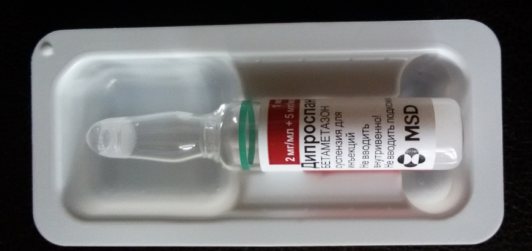
Injections of the drug quickly relieve the symptomatic picture of the disease and eliminate allergic manifestations. The remedy helps with frequent relapses of psoriatic pathology, has a strengthening effect on the immune system, prolonging the period of remission.
It has a pronounced effect on all metabolic processes in the body, due to which it is also possible to prolong the period of remission. The effectiveness of the drug in the treatment of psoriasis is ensured by its complex effect on the body.
Rapid absorption of the main component ensures the duration of the therapeutic effect for 24 hours. Betamethasone sodium accumulates in soft tissues, gradually being released, due to which its therapeutic effect persists for 10 days.
Patient reviews
Regarding the pharmacological drug, in addition to doctors, numerous patients who suffer from such an unpleasant illness and have undergone a course of therapy with this medication also leave comments. Positive reviews from patients about Diprospan for psoriasis reflect information that the medicine is excellent in relieving the symptoms of the disease. Patients note that inflamed psoriatic plaques heal quickly, signs of inflammation disappear, and the skin acquires a natural color and healthy appearance. Since the medicine is hormonal in nature, improvement in the patients' condition was observed quite quickly.

Negative reviews from patients about Diprospan for psoriasis in most cases describe a variety of side symptoms associated with the use of the suspension. Patients indicate the occurrence of dyspeptic symptoms, which occur with the development of attacks of nausea and disturbances in digestive processes. These are the most common side effects from using the medication. Various disorders in the functioning of the nervous system occurred less frequently. At the same time, patients experienced depression, mood swings, increased anxiety, headaches, and panic attacks.
We reviewed the instructions and reviews about Diprospan injections for psoriasis. We hope you now understand the features of the medication more clearly.
Antimicrobials Antibiotics
Doctors have noticed that when treating psoriasis patients for bacterial infections (scarlet fever, erysipelas, tonsillitis, rheumatism, other diffuse connective tissue diseases, nephritis, local and generalized purulent infection), psoriatic rashes regress.
In particular, treatment of streptococcal infection turned out to be effective for guttate psoriasis. (5 days of rifampicin taken orally in combination with a 10-14 day course of penicillin or erythromycin)
The inclusion of the antibiotic macrolide clarithromycin (500 mg/day orally for 14 days) in the course of treatment of psoriasis accelerates the regression of psoriatic rashes (by an average of 4 days).
According to O.B. Nemchaninova (2003), the prescription of the macrolide antibiotic vilprafen (orally 500 mg/day for 14 days) along with traditional methods of treating psoriasis was effective in the presence of psoriasis and urogenital chlamydia. This treatment, aimed at reducing susceptibility to infections, led to normalization of hematological and biochemical parameters, a decrease in the PASI index by 2.7 times and an increase in the duration of remission in 61% of patients.
In accordance with the protocol proposed by EW Rosenberg et al. (1998), the use of antibiotics and antimycotics is indicated for the treatment of psoriasis in the following cases:
1. When psoriasis is localized in seborrheic areas of the skin. In such cases, a 4-month course of ketoconazole (orally 200-400 mg/day) or daily use of shampoo with 2% ketoconazole is sufficient to resolve psoriatic rashes.
2. In the presence of rashes in the area of the extremities or torso, especially in the form of thin light pink plaques in persons under 30 years of age, usually carriers of beta-hemolytic streptococcus (groups A, B, C, D, G), which can be proven culturally ( culture of material from the pharynx on blood agar) and serologically (increased titer of antiDNAase B, antihyaluronidase, streptolysin and antistreptolysin-0 (increased titer of the latter in the absence of increased titer of the others is not associated with chronic carriage of beta-hemolytic streptococcus). To eliminate streptococcus, clindamycin ( 300 mg orally 4 times a day for 10 days) is more effective than penicillin, rifampicin, erythromycin.
3. If there are erythematous-squamous lesions or thick scales in the area of the palms and soles, when the pathological process is often associated with candidiasis of the oral cavity and pharynx. To exclude, culture of pathological material from the pharynx and dentures is carried out, and if Candida spp. fluconazole is prescribed (200 mg orally per day for 2-4 weeks), which is effective even for widespread psoriasis (Skinner et al., 1994).
4. In the presence of acute or clinically latent genitourinary infection caused by gram-negative pathogens, enterococci or group B ß-hemolytic streptococcus in middle-aged and elderly people with recurrent or widespread psoriasis.
5. For large psoriatic plaques in the sacral area, often associated with dysbiosis of the large intestine, which often develops against the background of diverticulosis. In this case, sulfasalazine is prescribed orally at a dose of 500 mg 4 times a day for at least 3 months. or a course of metronidazole of comparable duration, which is prescribed in a slightly lower daily dose.
6. If throat culture results are positive or anti-streptococcal antibodies are present in persons with signs of streptococcal carriage, if they have not stopped it after treatment with clindamycin or have relapsed. In this case, the “special method of treating psoriasis” is tonsillectomy.
7. For chronic psoriasis with damage to the nail plates. In this case, itraconazole is effective.
8. For psoriasis of large folds (inguinal, axillary, under the mammary glands, behind the ear, in the navel, etc.) and frequent sowing of group B or G beta-hemolytic streptococcus in them (in forms that are especially difficult to treat), Pseudomonas, Enterococcus or Klebsiella. A combination of systemic and local (clindamycin) antibiotics is recommended.
9. If you have rosacea (rosacea) or a history of damage to the upper digestive tract, the patient should be examined for Helicobacter pylori. In the presence of helicobacteriosis, it is recommended to take tetracycline (orally 500 mg 4 times a day), metronidazole (orally 500 mg 3 times a day), amiprazole (orally 20 mg 2 times a day) for 7 days.
Important addition: HPV type 66, what type is it and how to fight it
https://youtube.com/watch?v=JTNGT_Ise3M




